Medicinal laurel: agricultural technology and application
Laurel is a plant of the Rosaceae family. It is an evergreen perennial plant. About 80 of its species are known. In nature, it grows in the Transcaucasia, Ciscaucasia. Cherry laurel thickets can be seen in many European and Asian countries. There it grows in the shade of other trees, sometimes forming real thickets.
Content:
- Lavrovishnya: description and varieties
- Reproduction and planting
- Cherry laurel care
- Application in medicine
Lavrovishnya: description and varieties
Cherry laurel belongs to the genus Prunus (plum). There are many more species of this plant. The most famous of them:
- Portuguese
- Lusitanian
- Medicinal
Other names for medicinal laurel are pharmaceutical laurel, or ordinary. In places of natural growth, it is used to create hedges... Planted in parks and streets. At home, medicinal laurel is usually grown. It reaches 3-5 m in height. When grown indoors, it grows by 1.5 m. The crown diameter is the same as the height. The growth rate of the tree is average.
Perennial structure features:
- The root is strong and long. The bark of the trunk is gray.
- The branches of young plants are green, then turn gray. Smooth, may be slightly pubescent.
- Dark green leaves are whole-edged or with small denticles at the edges, dense, shiny, leathery. They are located alternately. The petiole is about 1 cm long.
- It blooms with small white flowers (petals 3 mm each) with a pleasant aroma. Each has 5 petals and 20 stamens. They are collected in brushes up to 13 cm long. Each of the brushes grows from the bosom of last year's leaf.
- The fruits are black drupes. In wild-growing forms, the diameter of each is about 8 mm, in garden ones - more. They can be eaten.
The fruit tastes good. But the leaves, bark, seeds of the fruit are poisonous. The stone is round, smooth. Contains hydrocyanic acid. Medicinal laurel blooms in April. This happens at the 4th year of life. It blooms and bears fruit regularly. Pods ripen from July to August. The cherry laurel can withstand frosts up to 17-20 degrees. She needs to be covered for the winter.
Reproduction and planting
Laurel cherry reproduces seeds, cuttings, layering or inoculation... Seeds germinate better if planted in the fall. And they do not retain germination for long. Therefore, you need to collect the seeds and sow them immediately. The next year, the plants are carefully transplanted to a permanent place. Take into account that root system young plants are weak.
Perennial cuttings:
- Cuttings for propagation are taken both apical and last year. The length of each is from 10 to 15 cm.
- They are cut in August or September. They are placed in the soil of peat and sand, taken in equal parts, to a depth of about 3 cm. Instead of peat, you can take humus.
- Drainage is placed below. You can use expanded clay.
- Install dishes with cuttings in an unheated room. This will solve the problem of frequent watering. Indeed, in an ordinary room, cuttings need to be watered in a greenhouse every 2 hours.
- After the cuttings have developed roots, they are planted in pots. They will stay there for a year.
- Then they are transplanted to a permanent place. If the roots are growing very quickly, you can transplant more often.
- Cherry laurel grown from cuttings retains all the properties of a "parent", which cannot be said about plants grown from seeds. In addition, with this method of reproduction, a new plant is obtained in one year.
There are 3 ways to propagate by layering. To use arcuate layering, you need to pin the twig to the ground and sprinkle it with soil. It is necessary to ensure that this area does not dry out. After the roots appear, the cut is cut off and transplanted separately. Reproduction by vertical layers consists in the fact that the branch is cut into a stump, 3 cm high.A green shoot 20 cm long is grown. Spud its soil, so that one top sticks out from the ground. Water regularly. In the fall, when roots appear on the layer, it is cut off and transplanted.
You can grow cherry laurel from a stone, and then, after a few years, an adult plant is grafted with a cuttings of the desired variety.
The soil for growing cherry laurel should be versatile, from slightly acidic to alkaline, dense. You can take the flower soil "Saintpaulia". Planted in spring or October. Young plants are watered. It is necessary to transplant into new soil every year until the plant reaches 5 years. Then the procedure is repeated every 2 or even 3 years, depending on the strength of the growth of the cherry laurel. If the plant is grown in a container, then replanting is not necessary. It is enough to remove the top, used layer of earth and replace it with a new, fertile one.
Cherry laurel care
Laurel is grown in open soil (in the southern regions) or in containers. They can be installed on terraces, in the yard, on the balcony, indoors.
Medicinal laurel is not demanding on growing conditions.
Grows well in cool rooms. Loves light, but can grow in a shaded area. It is installed in various offices, stairwells. Used to decorate shop windows. Can be installed in rooms with windows facing north or shaded. In summer, cherry laurel is taken out of the room into the fresh air into the garden. There she can stay until late autumn, while the first frosts come up. Laurel cherry tolerates air vibrations well.
Care Tips:
- The cherry laurel is not watered very much. In summer - once a week, in winter the period between waterings can last up to 2 weeks. Stagnation of moisture in the area of the root system must not be allowed. This can lead to the death of the plant. If it grows in the open field, then it is necessary to water it the next year after planting only in case of severe drought.
- Laurel cherry tolerates well pruning... Therefore, you can form a crown of the desired shape. Pruning is carried out at the end of winter.
- Fertilized in spring and autumn once a month with complex fertilizers for flowers. You can make organic... For one plant, 5 kg is enough per square meter of area.
- Laurel is practically not damaged by diseases. The main pest is scale insects and mealybugs. If the soil in which the tree grows is constantly wet, then the leaves are covered with dark heels and fall off. Mealy stains are removed with fungicides... These are manifestations powdery mildew.
Application in medicine
The fruits of the cherry laurel are eaten fresh and used to make drinks. From them and from the leaves, oil is obtained, which is used to make liqueurs. Wood is used as a material for making furniture.
Most of all cherry laurel is known as medicinal plant... The leaves contain a whole range of nutrients. These are glycosides, essential oils, tannins, some fats and even wax. These substances are used in medicine to treat many diseases:
- Amygdalin, which is part of the glycoside, forms hydrocyanic acid in the human stomach. But its doses are so small that they are only enough for an analgesic effect.
- The infusion of the leaves is used to treat certain nervous diseases. They are especially useful when the inflammatory process is gone, but irritability and arousal remain.Shown laurel cherry water in the treatment of respiratory organs, including the lungs. Helps relieve cough, chest pain.
- As an adjuvant, it is used for different types of tuberculosis.
- For the treatment of scrofula, cherry laurel drops are used together with antimony preparations, barium chloride and hemlock.
- Drops made from cherry laurel are used to treat cardiovascular diseases: arrhythmias, aneurysms.
- Applied for bleeding, including uterine, hemoptysis, abdominal cramps, pancreas, liver.
- As an auxiliary treatment, it is used in the treatment of uterine cancer, ovarian and prostate tumors, and gonorrhea.
- Laurel water is used externally and applied internally. So, externally used to treat hemorrhoids, eye inflammation.
But it is impossible to self-medicate when using this potent remedy. Indeed, in case of an overdose of the drug, suffocation, nausea and vomiting, headache, redness of the skin and mucous membranes may occur. Avoid contact with metal salts and carbonate salts.
More information can be found in the video:




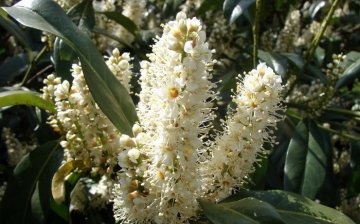
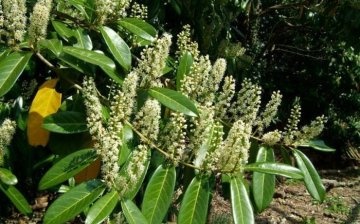
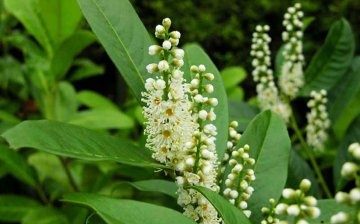
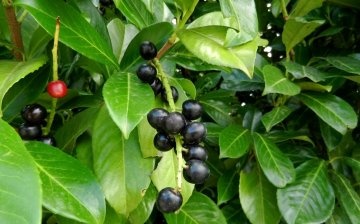





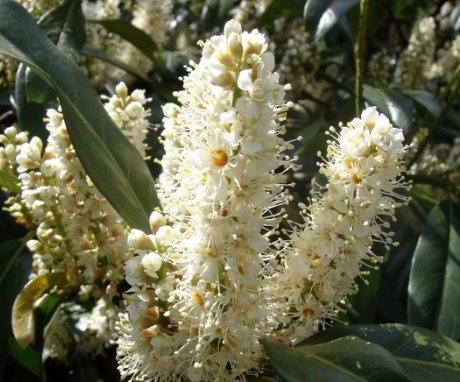
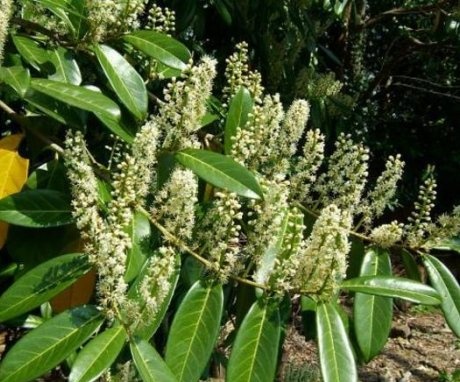


Despite the fact that cherry laurel has leaves that resemble bay leaves, they cannot be used to prepare various dishes. Grow cherry laurel, you need as an ornamental plant for a hedge around the site.